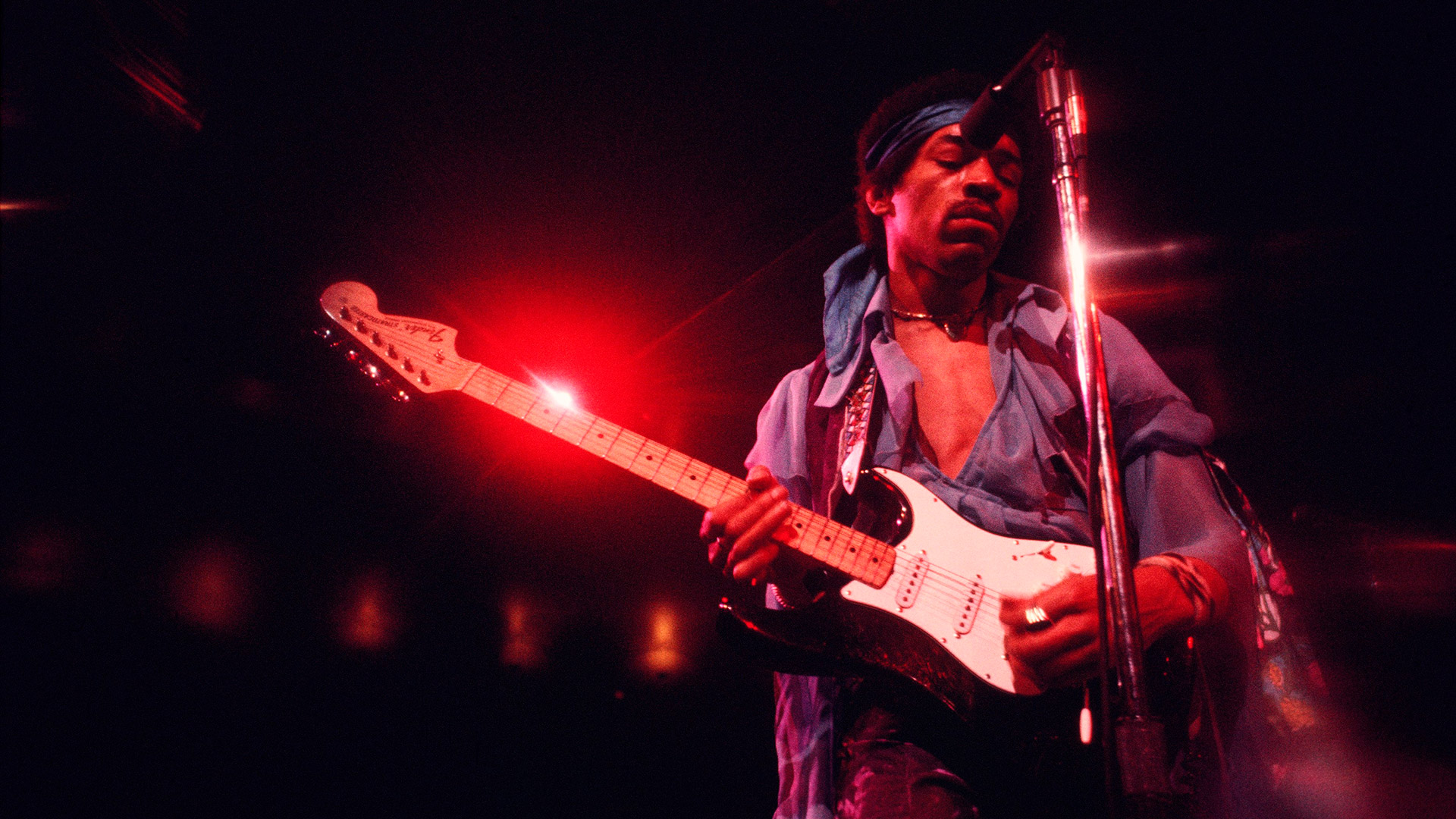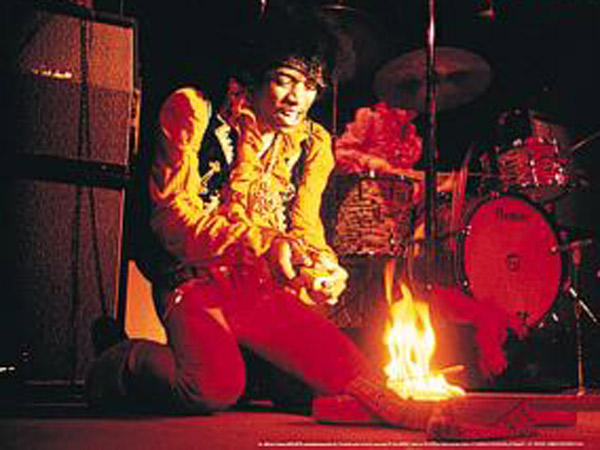He was the best guitarist not only of his time, but of history. Jimi Hendrix, in just four years, from 1966 until his untimely death in 1970, showed tremendous talent. His legacy lives on because he had it all: distortion and melody, psychedelia and rock, lyricism and power, rock and blues, sex and spirituality, virtuosity and passion.
He could play a theme of his own, a cover of a folk song like Hey Joe or Star-Splanged Banner, the American anthem, as in the closing of his Woodstock set. The result was always dazzling and innovative. It ranged from the ductile to the thunderous, as if no record was foreign to it.. During his lifetime he published three definitive and revolutionary albums. After his arrival, nothing was ever the same again. Every subsequent rock guitarist (and most of his contemporaries as well) is indebted to Hendrix. His music accomplishes something rare. He is a complete representative of an era and at the same time maintains the timelessness of the classics.
With Jimi it happens as with the great cracks of football. No matter how much someone wants to lay claim to the merit of the discovery, his genius was so evident that it was impossible for his time not to come.. The 12-year-old Maradona was far superior to the rest of the boys (still several years older than him) who played soccer; the same thing happened with twenty-year-old Hendrix and the other guitarists. Martians exercising (Martianly) human activities.
The founding myth states that it was brought to England by Chas Chandler, the former bass player for the Animals. Hendrix agreed to travel to Europe but demanded to play with Cream, the first super group. Eric Clapton, Ginger Baker, Jack Bruce. Cream He played music that nobody did in those years. Clapton was unattainable, the nickname they had given him defined his powers: God. It was inconceivable to share the stage with those monsters. However, Hendrix knew that he was up to the challenge. clapton chose KillingFloor, a very complicated song. Hendrix’s performance was stunning. They say that Eric Clapton left the stage and said to one of those close to him: “Nobody told me that this guy was so good”. That night Jimi Hendrix started the legend of him and became a deicide. It was the night that Hendrix killed God.

Then came the three albums, the trio, the Band of Gypsies, the shows, the big festivals.
His skill with the guitar allowed him exhibitionist gestures, pirouettes and tricks that displeased some purists. Playing behind the head, with the teeth, the guitar on fire on stage. The latter is an image that makes the metaphor of what happened in the most critical moments of his performances too crude. Jimi Hendrix was a force of nature.
At the end of August 1970, just three weeks before his death, he had a great night in the middle of New York. Many important musicians went to his house, to his new house. Mick Fleetwood, Johnny Winter and Yoko Ono toasted and strolled through the different environments of Electric Lady Studios, the recording studio that Jimi had built. It was quite a novelty for his time: the first big star who built a big professional studio with his money (He invested about a million dollars at the time). In addition to making it possible for other artists to record his albums, this would be the laboratory in which the guitarist would experiment, in which he would seek his new paths and innovations, which at that point seemed inevitable. It is difficult to predict what never happened, but the artistic pursuits that Hendrix had undertaken in those last months (and his congenital restlessness) seem to indicate that.
What he had always dreamed of, at one point, became his conviction. The pressure of the media, the success, the public, the shows one after the other. She spent her last three years on a kind of permanent tour. In his childhood and adolescence he longed to be a musician. He had succeeded but he was involved in a web of contracts and demands that was undermining him. The same thing happened with the fame, sudden, brutal and crushing. “I don’t want to be a rock star anymore, I don’t want to be a clown,” he declared. Hence the search for him and the intention that his career would take a new turn. “I’m going to form a big band, no longer a trio. Explore where that takes me,” he told an English journalist in August 1970.
After his studio launch party, Hendrix traveled to London. In Europe, performances awaited him at a couple of festivals, a Scandinavian tour and shows in London, the city in which he made himself known to the world.

Hundreds of thousands of people (the number depending on who provides it ranges between 300 and 600 thousand) heard it at the Isle of Wight Festival. The cast was impressive: The Doors, Joni Mitchell, Leonard Cohen, Sly and The Family Stone. He played very late -almost a habit of his- and the show presented several problems, including sound.
In Sweden and Denmark he was adored. There he made several presentations. Then a new festival. This time in Germany, on the Island of Fehmarn. Again the delay until dawn. A deluge and the delay caused the audience to boo him and throw things on stage. Keep in mind that in those massive festivals of the late sixties, every minute that an artist was late caused several collapses due to excess of hallucinogens and other drugs. “If you’re going to whistle and boo at me, at least do it in tune,” the guitarist asked sarcastically. Already on stage, already with the music running, magic took over the place. That was his last live show.
At midnight on September 18, 1970, he went on stage to accompany War and its leader Eric Burdon. He was applauded as always. He drank a lot of alcohol and did some drugs surrounded by beautiful women, too, like always. At some point, he rescued it – or Monika Dannemann monopolized it. She was one of several girlfriends that the musician had simultaneously. Well into the morning they went to the hotel where she was staying in the English capital, the Samerkand. She made him a tuna sandwich, they talked and drank wine. Despite the tiredness and the hour, Hendrix could not fall asleep. He told Monika that he was going to take something to do it. It was already almost 7 in the morning. She almost immediately fell asleep. From then on, the facts (or the account of them) become imprecise.
Monika says that she woke up three hours later and seeing him asleep, she decided to go downstairs to buy cigarettes. Just when he returned, he noticed that, lying on his back, a thin thread of vomit slipped through his lips. She tried to wake him up and getting no response she called for help. This is one of the versions given by the woman (who died in 1996 when she was 50 years old, presumably by suicide). She contradicted herself several times in the following days. At some point she said that as soon as she woke up she saw the picture that worried her and that she was desperate for not being able to wake him up.
Other versions say that she got scared and called Eric Burdon, with whom they had been until a few hours ago. He told her to call an ambulance immediately, but she said that was impossible: the press would find out about her and there were too many drugs in the room. Burdon told him to call 911 and flush the drugs down the toilet. The ambulance quickly arrived at the hotel but stayed there for a long time. More than half an hour. There are several hypotheses: some maintain that Monika took several minutes to open them because she was eliminating the incriminating substances; Others say that what she held him for was that they did the resuscitation maneuvers right there but that everything was unsuccessful; while there are those who believe that at that time they tried to stabilize her vital signs.

The conflicting accounts continue. There are witnesses who maintain that he got into the ambulance alive; others swear that he was carried with his head hanging back – worsening the drowning situation. One of the doctors affirms that the guitarist arrived dead, while another declared that the death occurred in the hospital ward.
The years, instead of providing clarity, only deepened the conflicting versions and suspicions. There was talk of accidental death, suicide and even homicide (in that case suspicions always pointed to Monika but as an instrument of the CIA or the FBI due to the link between Jimi and the Black Panthers: an unlikely theory). Each one of those who uphold a theory emphatically defends it.
What was determined was that Hendrix had taken between 8 and 9 Vesperax, a strong sleeping pill. The usual thing for anyone was to take a pill or a half. But between his usual mixtures of drugs and alcohol and the almost daily use of this medication, a single pill had no effect on Hendrix, who wanted to ensure a good number of hours of sleep. According to one of the doctors he had so much wine in his body that “It seemed as if a bottle had been dumped down his throat.” The final report determined that the cause of death was “inhalation of vomit due to barbiturate poisoning”.
The streak, that year, had started 15 days earlier and would end a month later. On September 3, in the hills behind the house of one of his bandmates, Alan Wilson, leader of the blues group, was found dead of an overdose. Canned Heat: his disappearance was overshadowed by the two that followed. A month and a day later, it was Janis Joplin who died. In the middle of them, Hendrix. The three, in addition to being musicians, were 27 years old.

Those were wild times, of excesses. But the coincidence of the age caused the Club of 27 to be talked about, an age that many music greats could not overcome. The list is profuse: the pioneer was Robert Johnson, then in 1969, Brian Jones. After the triad of 1970, in the middle of the following year it was Jim Morrison’s turn. And further back in time, Kurt Cobain and Amy Winehouse, among others, were added to the macabre list.
After Jimi Hendrix’s death, his records continued to appear. Unpublished, discards, live shows. More than 50 albums with his music were published. Half a century after his death, his music lives on. A few weeks before he died he had declared: “The expression blowing your head is valid. But we’re going to give people something that’s going to blow their minds, but as long as they’re blowing their minds, there’s going to be something that’s going to fill that gap. It’s going to be absolute music.” Time confirms that he got it.
KEEP READING:

